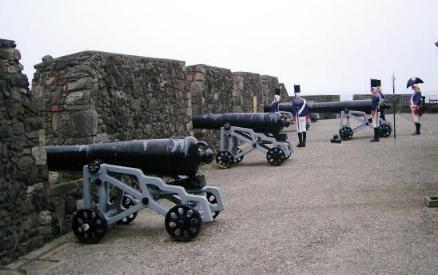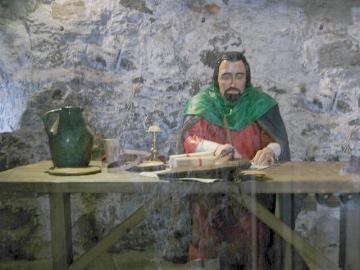|
The Castle's Dungeon's.
|
Castle
Dungeons. |
||
|
Mention the word Dungeon 'donjon' was the name used for the castle's main tower before it became known as the keep. Prisoners could have been kept in several places throughout Carrickfergus castle, there is reference to the gatehouse being used in 1576. Probably the most secure would have been the 'oubliette' a room to which the only access is through a trapdoor in the ceiling. It is unlikely the vault under the main keep housed prisoners, it was probably used to store wheat, cloth and possibly valuables, many of which would have been the spoils of war. Prisoners would have been housed
according to their social rank, Many prominent people in Irish history have been incarcerated in the castle, some of these may have spent their time quite comfortably, often people of rank were allowed their own servants, and would have been at liberty to move about within the castle, as the gate was guarded at all times. One of these was Conn O'Neill of Clandeboy in 1603, another was Randall MacDonnell 1642 - 43, the latter managed to escape twice and O'Neill once. These people were in the fortunate position of being able to offer bribes to secure their escape, in O'Neill's case it appears his escape was arranged by Hugh Montgomery not of course for the love of O'Neill but to secure thitle to some of his land. |
||
|
|
 dungeon and people immediately associate it with a cold forbidding room
in the bowels of a castle, with some poor wretch in rags chained to
a damp wall, dreading the appearance of the jailer, who may be liable
to inflict all manner of unspeakable torture on him. And indeed this
is probably an accurate assessment of the situation many thousand of
unfortunate individuals found themselves in throughout the history of
Ireland. There are many documented cases where men and even women of
rank have been deliberately starved to death.
dungeon and people immediately associate it with a cold forbidding room
in the bowels of a castle, with some poor wretch in rags chained to
a damp wall, dreading the appearance of the jailer, who may be liable
to inflict all manner of unspeakable torture on him. And indeed this
is probably an accurate assessment of the situation many thousand of
unfortunate individuals found themselves in throughout the history of
Ireland. There are many documented cases where men and even women of
rank have been deliberately starved to death. soldiers of low rank would have endured the worst conditions. On the
24th June 1316 during the period when Edward Bruce was besieging the
castle thirty Scottish soldiers were seized during a parley, one report
states that six of these were killed and eaten before the castle surrendered
in September, in reality the prisoners may have died, with food acutely
short, it's entirely conceivable the prisoners didn't receive a fair
share. Prisoners were often sent from Dublin for safekeeping, if it
was considered their kinsmen might attack Dublin to secure their release.
In 1760 French soldiers were held in the castle. After the 1798 rebellion
many of the captured rebels of the area were held there pending sentence.
soldiers of low rank would have endured the worst conditions. On the
24th June 1316 during the period when Edward Bruce was besieging the
castle thirty Scottish soldiers were seized during a parley, one report
states that six of these were killed and eaten before the castle surrendered
in September, in reality the prisoners may have died, with food acutely
short, it's entirely conceivable the prisoners didn't receive a fair
share. Prisoners were often sent from Dublin for safekeeping, if it
was considered their kinsmen might attack Dublin to secure their release.
In 1760 French soldiers were held in the castle. After the 1798 rebellion
many of the captured rebels of the area were held there pending sentence.